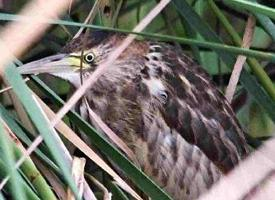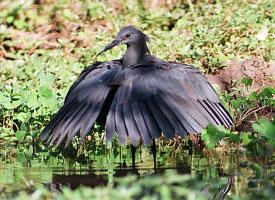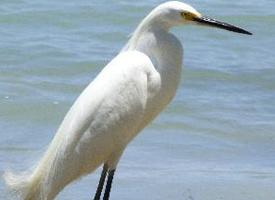
Állatleírás
The Little Bittern (Ixobrychus minutus) is a fascinating and elusive bird species belonging to the heron family, Ardeidae. Characterized by its diminutive size, this bird is the smallest member of its family, making it an intriguing subject of study for bird enthusiasts and ornithologists alike. The Little Bittern is known for its secretive behavior, often hiding in dense vegetation near water bodies, which makes it a challenge to observe in its natural habitat.Adult Little Bitterns exhibit sexual dimorphism, meaning males and females have distinctly different appearances. Males boast striking plumage with a glossy black crown and back, contrasting beautifully with their buff-yellow underparts and chestnut-colored sides. Their wings display a mix of black and chestnut, with conspicuous large white patches that become visible during flight. Females and juveniles, on the other hand, are more subdued in coloration, featuring brownish tones with a mottled appearance, which provides excellent camouflage among reeds and vegetation.
These birds are relatively small, with a body length ranging from 25 to 36 centimeters and a wingspan of approximately 40 to 58 centimeters. Despite their small size, Little Bitterns are adept fliers and can cover considerable distances during their migratory journeys. They are primarily nocturnal, with much of their activity, including feeding, occurring from dusk till dawn.
The diet of the Little Bittern primarily consists of a variety of aquatic prey. They feed on fish, amphibians, crustaceans, and insects, skillfully catching their prey with quick thrusts of their sharp beak. Their hunting strategy involves standing still or walking slowly at the water's edge, patiently waiting to strike when prey comes within reach.
Breeding behavior of the Little Bittern is as secretive as their general lifestyle. They nest in dense vegetation close to the water, constructing platforms of reeds and plants. The female typically lays between 4 to 6 eggs, which are incubated for about 17 to 19 days. Both parents are involved in feeding and protecting the young, which fledge the nest after about 25 to 30 days.
The Little Bittern has a wide distribution range, encompassing parts of Europe, Asia, Africa, and the Middle East. They are migratory birds, with populations in Europe and northern Asia moving south to Africa and southern Asia to escape the cold winter months. Despite their extensive range, habitat loss and degradation pose significant threats to Little Bittern populations in certain areas, emphasizing the need for continued conservation efforts.
In conclusion, the Little Bittern (Ixobrychus minutus) is a small yet remarkable bird, captivating observers with its striking appearance and elusive nature. Its adaptability to aquatic environments, combined with its secretive behavior and distinctive breeding habits, make it a unique species within the heron family. Despite facing challenges related to habitat loss, the Little Bittern continues to thrive in suitable environments across its broad range, symbolizing the resilience and diversity of wetland ecosystems.
Hasonló állatok
Új állatfotók
Top 10 állat
- Dolphin gull (Leucophaeus scoresbii)
- Japanese macaque (Macaca fuscata)
- Stone loach (Barbatula barbatula)
- Russian tortoise (Testudo horsfieldii)
- Galápagos tortoise (Geochelone nigra complex)
- Greek tortoise (Testudo graeca)
- Diana monkey (Cercopithecus diana)
- Common flying dragon (Draco volans)
- Moustached guenon (Cercopithecus cephus)
- Galápagos penguin (Spheniscus mendiculus)


